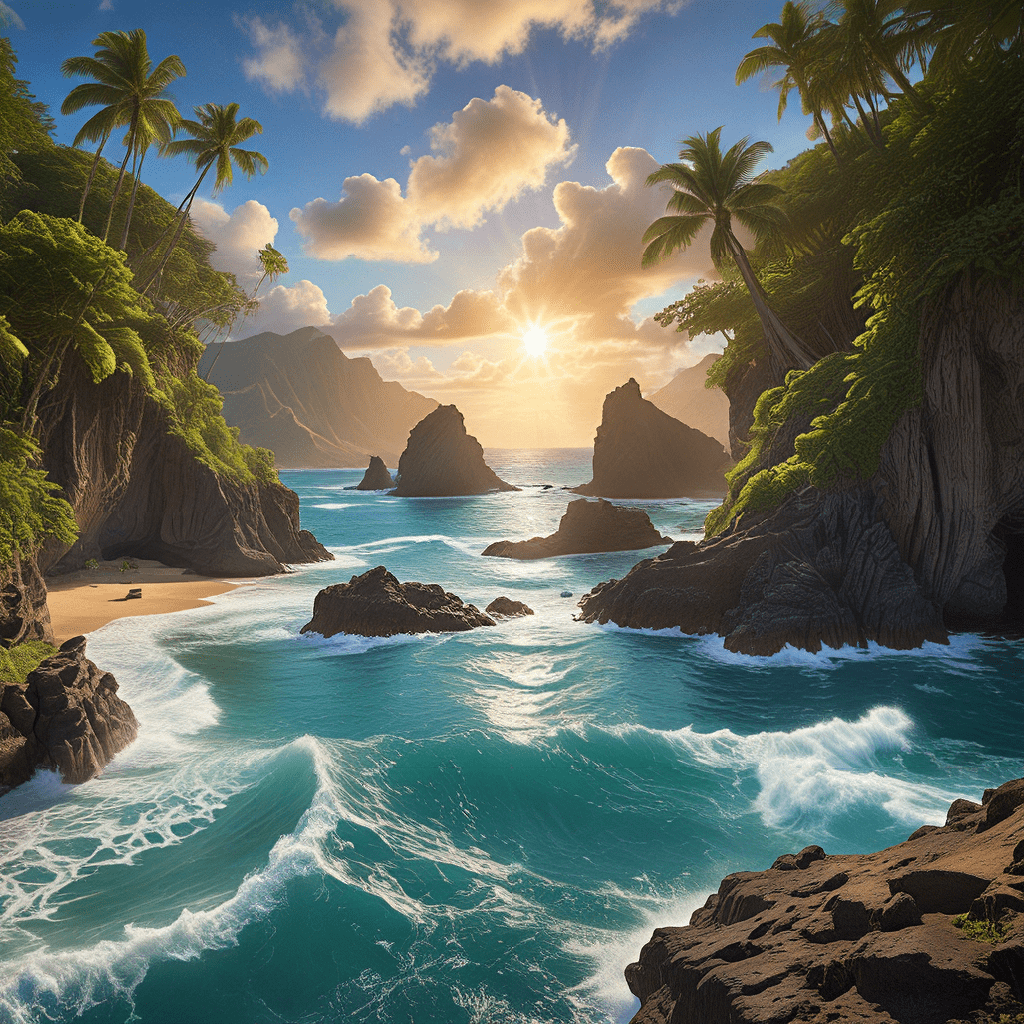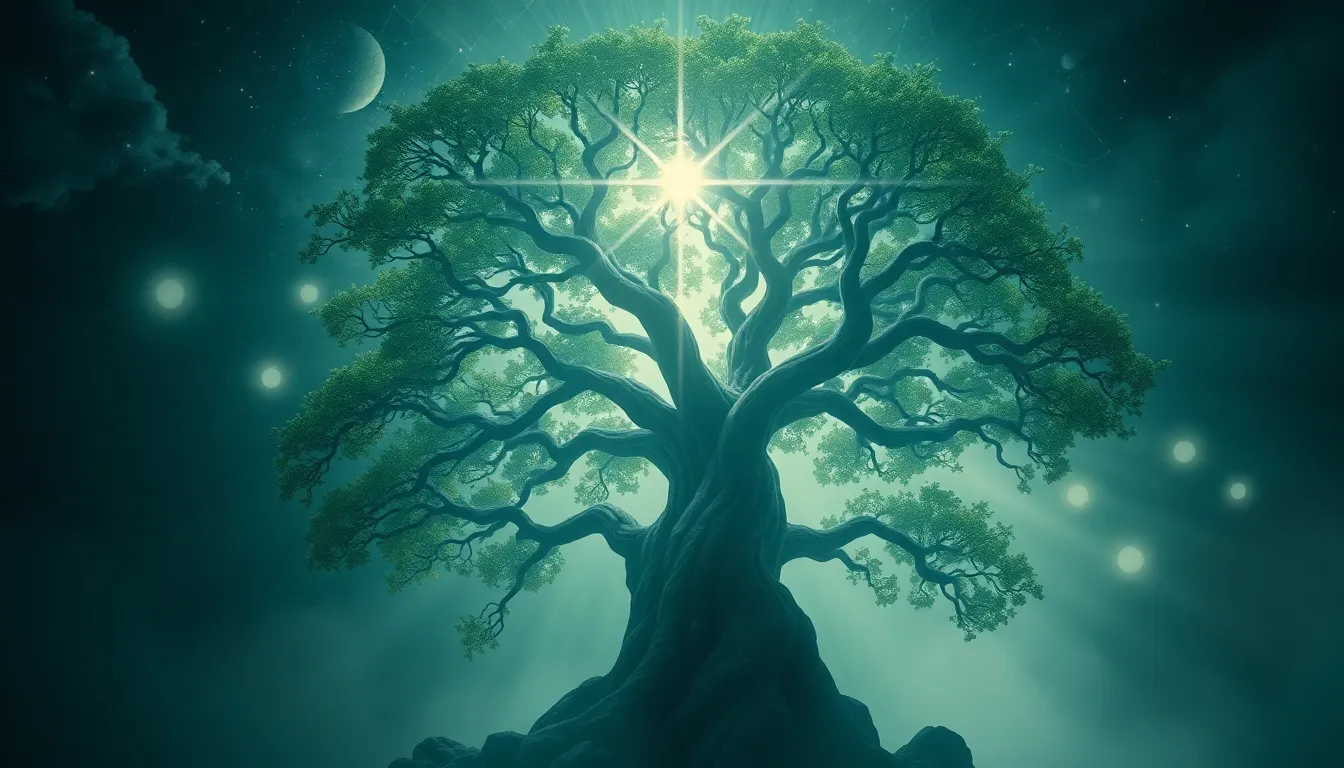Hawaiian Creation Myth: The Birth of the Islands
The Hawaiian Islands, a chain of volcanic peaks rising from the vast Pacific Ocean, are renowned for their stunning beauty and rich cultural heritage. But beyond their picturesque landscapes lies a captivating world of mythology, where the islands themselves are believed to have sprung from the very essence of creation. In Hawaiian mythology, the origins of the islands are intricately woven into the fabric of their beliefs and traditions, providing a profound connection between the people and their land.
The Hawaiian creation myth, like many others, tells a story of a world born from chaos and shaped by divine intervention. At the heart of this myth lies the concept of "Pō", the primordial state of nothingness, representing infinite potential and the source of all things. From Pō emerged "Wākea", the sky father, and "Hāwea", the earth mother, symbolizing the fundamental duality of creation. Their union, a union of opposites, gave birth to the first generation of gods, who in turn, brought forth the land, the sea, and all living things.
The Role of the Gods in Hawaiian Mythology
In Hawaiian mythology, gods play a pivotal role in shaping the natural world and influencing human affairs. These gods, known as "akuas", are not remote or unapproachable but rather, are deeply intertwined with the lives of the people. They are associated with various aspects of nature, including volcanoes, storms, oceans, and the land itself.
Each akua holds a specific domain and possesses unique powers and characteristics. For instance, Kū, the god of war and agriculture, is depicted as a strong and steadfast figure, while Lono, the god of peace and prosperity, is associated with the harvest season and fertility. These deities, with their distinct personalities and powers, embody the forces that govern the natural world and guide the destinies of humankind.
The Story of Kumulipo: The Hawaiian Genesis
The Hawaiian genesis story, known as the "Kumulipo", is a long and intricate chant that traces the lineage of the islands and their people back to their divine origins. It's a powerful narrative that encapsulates the essence of Hawaiian cosmology, revealing the intricate relationship between the physical universe and the spiritual realm.
The Kumulipo begins with the emergence of the primordial gods, Wākea and Hāwea, from the void of Pō. Through a series of generations, the chant recounts the birth of the gods, the creation of the natural world, and the arrival of the first humans. It speaks of the interconnectedness of all things, emphasizing the importance of honoring the ancestors and preserving the ancestral wisdom passed down through generations.
The Significance of Volcanoes in Hawaiian Creation
Volcanoes, the very forces that shaped the Hawaiian Islands, hold profound significance in Hawaiian mythology. They are seen as powerful manifestations of the gods, representing the raw power and dynamism of creation. The Hawaiian word for volcano, "mauna", literally means "mountain", emphasizing the volcanic origins of the islands and their importance in the cultural landscape.
The most famous volcano, Mauna Kea, is considered to be the sacred mountain of Hawaii, reaching for the heavens and symbolizing the connection between the earthly and the celestial realm. The volcanic eruptions, although potentially destructive, are viewed as a vital part of the natural cycle, giving rise to new land and enriching the soil, making it fertile for life.
The Myth of Pele and Her Sisters
One of the most popular Hawaiian myths centers around the fire goddess Pele and her sisters. Pele, a fierce and vengeful goddess, is believed to reside within the volcanoes of Hawaii, her fiery power manifested in the molten lava that erupts from their craters. According to legend, Pele travelled across the Pacific, searching for a permanent home for her fiery spirit, leaving behind a trail of volcanic activity wherever she went.
Her sisters, who represented various aspects of nature, followed in her wake, creating the islands and their diverse ecosystems. Although Pele's power can be destructive, she is also seen as a force of renewal, constantly shaping the land and bringing forth new life. The myth of Pele and her sisters highlights the connection between the islands, their volcanic origins, and the cycle of creation and destruction that governs the natural world.
The Importance of Land and Sea in Hawaiian Mythology
The Hawaiian Islands are a testament to the interconnectedness of land and sea. Hawaiian mythology reflects this deep connection, recognizing the vital roles both play in their cultural identity and survival. The islands themselves are seen as gifts from the gods, rising from the ocean depths, forming a haven for the people. The sea, a vast and powerful force, provides sustenance, transportation, and spiritual connection.
In traditional Hawaiian society, the ocean was revered as a source of life, providing food, transportation, and a pathway to other islands. The ocean was seen as a sacred space, home to various akuas, including the shark god, Kaʻiwi, and the goddess of the sea, Kamehameha. These deities were believed to protect both the ocean and those who relied upon it.
The land, too, held immense significance, providing resources, shelter, and a sense of belonging. The volcanic mountains were sacred places, connected to the gods and the ancestors. The forests, teeming with life, were seen as a haven for spirits and a source of valuable resources. The land and sea, in their interconnectedness, formed the foundation of Hawaiian identity, shaping their values, traditions, and their understanding of the universe.
Theories on the Origins of the Hawaiian Islands
While Hawaiian mythology offers a compelling explanation for the islands' creation, scientific understanding reveals a different story, one rooted in geological processes. The Hawaiian Islands are formed through a process called volcanism, a phenomenon driven by the movement of tectonic plates.
The Earth's crust is made up of large plates that constantly move and interact with each other. The Pacific Plate, where Hawaii sits, is slowly moving over a "hot spot," a region within the Earth's mantle where magma—molten rock—rises from deep within the Earth. As the plate moves, the rising magma erupts through the ocean floor, forming volcanic mountains that eventually break the surface of the sea and create islands.
Volcanic Activity and Plate Tectonics
The volcanic activity that formed the Hawaiian Islands continues to this day, creating new volcanic features and shaping the landscape. The islands are still growing, with new volcanoes emerging on the ocean floor, eventually becoming part of the island chain.
The movement of the Pacific Plate also explains the age and location of the islands: The oldest islands are located to the northwest, while the youngest are found to the southeast, directly over the hot spot. This pattern demonstrates the ongoing process of island formation and the profound influence of geological forces on the Earth’s surface.
The Role of Polynesian Navigation and Exploration
While the islands themselves are a product of geological forces, their cultural heritage is a testament to the extraordinary skills and courage of Polynesian navigators. These intrepid voyagers navigated vast distances across the Pacific Ocean, using the stars, currents, and wind patterns to reach new lands.
The Polynesians were meticulous observers of nature, developing a sophisticated understanding of the celestial bodies, the ocean currents, and the behavior of the wind. This knowledge, coupled with their advanced boat building skills, enabled them to voyage across thousands of miles of open ocean, reaching the far-flung islands of the Pacific, including Hawaii. Their arrival in Hawaii marked a pivotal moment in the islands' history, bringing with them their unique culture, language, and traditions.
Modern Interpretations of Hawaiian Mythology
In modern times, Hawaiian mythology continues to be a source of inspiration and guidance for the people of Hawaii. The stories, traditions, and beliefs passed down through generations provide a framework for understanding the world, connecting with the natural environment, and forging a sense of identity.
While scientific understanding has offered a more tangible explanation for the islands' origins, the myths remain relevant and powerful, capturing the essence of the Hawaiian spirit and the deep connection between the people and their land. These stories remind us of the forces that shaped the islands, the resilience of the people, and the enduring power of cultural traditions.
FAQ:
What are some of the key elements of Hawaiian mythology?
Hawaiian mythology is rich with stories about gods, goddesses, and nature spirits. Key elements include the creation of the islands from the primordial void, the importance of volcanoes, and the role of the ocean in Hawaiian life.
Why is Pele, the fire goddess, so important in Hawaiian mythology?
Pele, the fire goddess, is a powerful deity associated with volcanoes and fire. Her stories are a reminder of the islands' volcanic origins and the destructive yet creative force of nature.
What is the significance of the Kumulipo?
The Kumulipo is a long chant that traces the lineage of the islands and their people back to their divine origins. It's a vital source of information about Hawaiian cosmology and creation myths.
What role did Polynesian navigation play in the settlement of Hawaii?
Polynesian navigators, with their advanced seafaring skills, were crucial in reaching Hawaii and establishing a cultural presence on the islands. They used their knowledge of the stars, currents, and winds to navigate vast distances.
How is Hawaiian mythology relevant today?
Hawaiian mythology continues to be a source of inspiration and guidance for the people of Hawaii. It helps people connect with their heritage, understand the natural world, and foster a sense of community.




